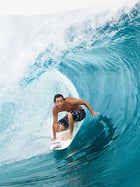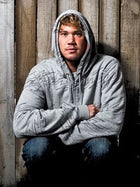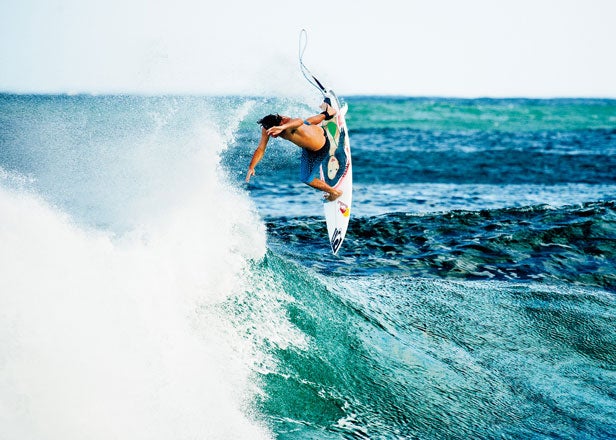Watch a video of Jordy Smith surfing.
Jordy Smith
 In the barrel at Tahiti's Teahupoo
In the barrel at Tahiti's TeahupooJordy Smith
 Smith at Jeffreys Bay, South Africa, in 2009
Smith at Jeffreys Bay, South Africa, in 2009JORDY SMITH shouldn’t be here.
We’re paddling out at Newport Beach, in Orange County, on an unseasonably cold morning in early September. The first waves of a coming south swell are uninspiring two-footers. Smith, ranked number one on the Association of Surfing Professionals (ASP) World Tour, should be 30 minutes south, at Trestles. Not only are the waves better there; it’s the site for the next World Tour event, which starts tomorrow.
Instead, the lanky 22-year-old South African is here, hiding out—or at least trying to. Wrapped in a teal wetsuit with a flop of brown hair, he looks like one of the local kids in the lineup. Then he drops onto a set wave, cuts back up the face, launches a giant aerial 180, lands backwards at full speed, whips around, tears down the line, and … casually steps off his board in knee-deep water. The others surfers gawk in silence. It’s as if LeBron had sneaked into a pickup game.
I ask Smith if he thought about practicing at Trestles today.
“Nah,” he laughs, “too much of a scene down there.”
Such indifference is characteristic of Smith, who’s cocky enough to believe that talent alone will soon make him a world champion. The thing is, he’s probably right. Armed with an arsenal of explosive, halfpipe-inspired aerial maneuvers, Smith is the head of a new class of surfers who are concerned more with what happens above a wave than on it. While Kelly Slater introduced aerials to competitive surfing 20 years ago, Smith is now pushing the sport higher, launching snowboard-like big-air tricks with twists, spins, and flips. And he’s literally changing the rules. This year, to keep up with advances made by Smith and fellow young guns like American Dane Reynolds, the ASP rewrote its judging criteria.
“Jordy and Dane made airs functional,” says Brendon Thomas, editor of Surfer. “Nobody had done that before.”
Nor has anyone arrived on the pro scene with Smith’s combination of skill and bravado. During his rookie year on the World Tour, in 2008, Smith boasted that he could win the overall title. (He ended up finishing 26th.) He also granted an infamous interview to Australian surf tabloid Stab, in which he described his sexual exploits with older women in gruesome detail. Other pros were not impressed. “Everybody on the tour that year wanted to crush me,” Smith says now. “I guess they proved their point.”
Indeed, it was a rocky start to a much-anticipated career. Smith had grown up in a rough part of Durban, where he learned to surf with his dad, a board shaper. Smith’s friends, like fellow South African pro Damien Fahrenfort, recall sleepovers interrupted by the broken glass of robberies next door. The family had little money and held garage sales to finance travel to regional contests. Smith remembers a six-to-eight-month period when his family survived on a powdered calorie drink called ProNutro.
His first big break came in 2006, when, at 18, he scored a wild-card berth in a World Tour event at Jeffreys Bay, ten hours south of Durban, and made it all the way to the semifinals. That December, he earned a spot in the Vans Triple Crown of Surfing, the three-event showdown in Hawaii that caps the ASP World Tour, pulling off a stunning second-place finish at Sunset Beach. The next year, Smith joined the World Qualifying Series—the ASP’s minor leagues—and amassed more points than anyone in history.
On track to make the World Tour, Smith got into a contract dispute with then-sponsor Billabong. His tactic: tear their stickers off his boards, self-finance his travel to events, and let the industry know he was looking for a new label. The marketers responded. In a sport where brands aggressively court only a handful of big names, the attention paid to Smith “was completely unprecedented,” says veteran surf journalist Matt Warshaw, author of The History of Surfing. The last time there was this much hype about a rookie was 1991—when Slater joined the tour.
Nike flew Smith on a private plane to Portland to meet with founder Phil Knight, then had Tiger Woods call with a sales pitch. Industry heavyweights hosted lavish dinners and put Smith’s family up at the Ritz. The process was surreal. “I think about it now and I’m like, What the hell was that?” he says. Ultimately, Smith signed a seven-figure annual deal with wetsuit company O’Neill. “We were looking for a franchise player,” says their director of sports marketing, Garth Tarlow. Among Smith’s first purchases with his newfound cash was a new home for his parents in Durban.
When the 2008 tour started, Smith was ready to talk trash but unprepared for elite-level competition. The contests were held at intimidating spots he’d never surfed, like Tahiti’s Teahupoo. He didn’t even know where to sit in the lineup. Still, his sponsors stuck with their new star, even going along with the Lothario image projected in the Stab article. One sponsor, shoe brand DVS, produced a magazine ad with Smith in front of a quiver of boards painted with busty women. The tagline: RIDDEN HARD AND PUT AWAY WET.
Even as he lost contests, placing 26th in 2008 and 11th in 2009, Smith’s talent was on display. Video clips circulated of him working remarkable moves into his rides—huge airs and spinning flips where he steps off the board midflight. Problem was, judges couldn’t score them. Pressure mounted on the ASP to adapt, peaking when Slater, who could see that a shake-up would make the sport relevant to a wider audience, threatened to help start a new tour. Before the 2010 season, the ASP made sweeping changes to emphasize “innovative, progressive maneuvers.”
Smith returned eager. He trimmed the baby fat off his bulky six-two frame and stopped worrying about what works for the judges. “When I go freesurfing, I have my best waves,” he says. “I wanted to take that same approach to contests.”
The strategy paid off. In July, he won his first World Tour event, at Jeffreys Bay, and has finished in the quarterfinals or better at six out of seven contests. He’s also learned to tone down the chest thumping. On the tour, he travels with his dad and an entourage of trusted old friends from Durban, and his home base is a room he rents from O’Neill’s Garth Tarlow in Newport.
“Jordy has matured so much in one year,” says Thomas, the Surfer editor. “You can see the difference in how he speaks and acts.”
Still, it’ll probably be another year or two before you see him lifting the ASP trophy. After we surfed Newport, Smith cruised through heats at Trestles, linking big airs and powerful turns. But he broke two boards, then wiped out in the quarterfinals. Slater, who’d been behind Smith in the ASP rankings, pounced, winning the contest and moving into first place overall as he vies for his tenth world title.
Smith was disappointed, but he hasn’t abandoned his attitude. As he puts it: “Wax your board and go out and do huge airs.”


